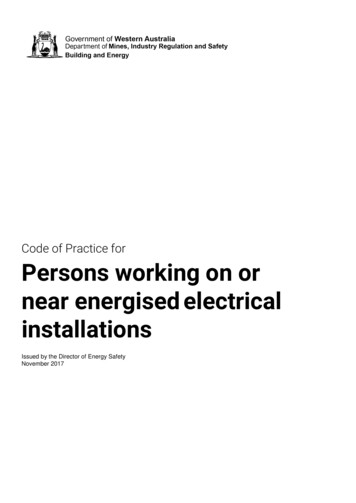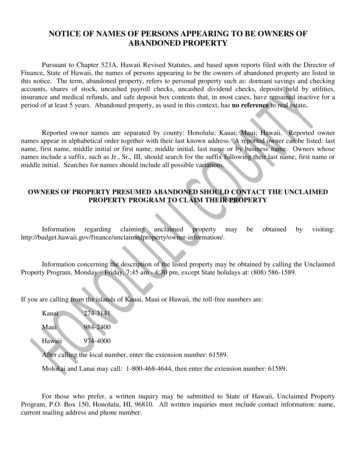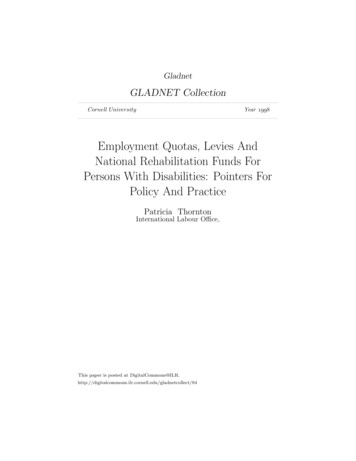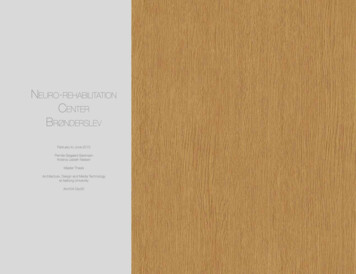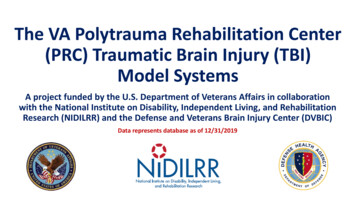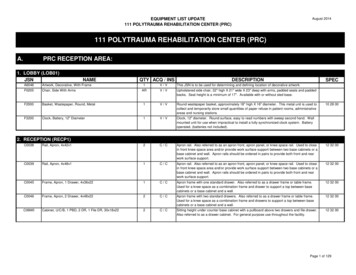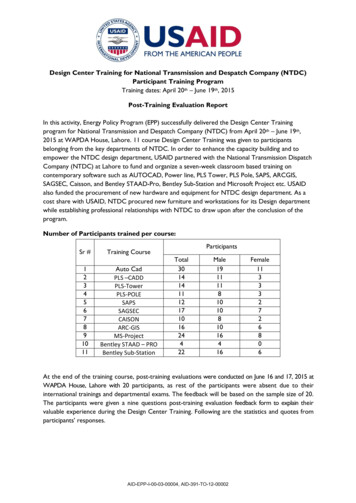
Transcription
National Rehabilitation Centerfor Persons with DisabilitiesFor independent life and social participationAddress:TEL:FAX:URL:E-mail :4-1 Namiki, Tokorozawa, Saitama 359-8555 Japan 81- 4-2995-3100 81- 4-2995-3102 or 3661http:// www.rehab.go.jp/ english/ index.htmlkikakuka @ rehab.go.jp
Message from the PresidentYoshiko Tobimatsu,President1National Rehabilitation Center for Persons with Disabilities (NRCD) is a nationalorganization conducting provision of medical care and welfare services, development of new technologies and assisting products, research contributing tonational policies, human resources development of rehabilitation professionalsand international cooperation to support independent life and social participation of persons with disabilities.NRCD was established in 1979. The needs for NRCD have changed in accordance with the subsequent social changes. In order to adapt to the changes insocial needs, the function of National Rehabilitation Center for the Disabledwas restructured to be an organization focusing on full range of disabilities,and the center was renamed “National Rehabilitation Center for Persons withDisabilities” in 2008.For higher brain dysfunctions caused by head injury or cerebral vascular accident (CVA) and developmental disorders, NRCD provides medical rehabilitationaiming at their independence in Hospital and social rehabilitation aiming atsocial participation and returning to work in Rehabilitation Services Bureau. Inaddition to these services, NRCD has Information and Support Center to collect,analyze and provide domestic and international information. Research Instituteconducts development of assistive products and technologies as well as fundamental research for such disabilities.Furthermore, NRCD has been working on rehabilitation for cervical cordinjury, spinal cord injury, elderly persons with amputation and so on that arehard to treated by other medical and welfare organizations. Today we havestarted rehabilitation for stuttering and low vision which rehabilitation servicesare under development in Japan, and providing the information nationwide.NRCD is also working on health promotion and healthy life expectancy ofpersons with disabilities.We disseminate and cultivate rehabilitation methods through various shortterm training programs. We accept visits and training not only from Japan, butalso from overseas.We would like to appreciate your support and cooperation. Your visit to ourcenter would be cordially appreciated.Purpose of Establishment/ ServicesPurpose of EstablishmentThe National Rehabilitation Center for Persons with Disabilities (NRCD) provides advanced andcomprehensive healthcare, medical care, and welfare services to assist persons with disabilities(PWDs) in maintaining and recovering their overall living functions under an integrated systemthat provides services ranging from medical care to vocational training. Our mission is to promoteindependence and social participation of PWDs through our services. As a core institution forrehabilitation for PWDs, the NRCD also takes a leading role in the research and development ofrehabilitation techniques and assistive products, and the cultivation of specialists in rehabilitation.To better contribute to promotion of scientific evidence-based medical care and welfare policies, the NRCD assesses and analyzes clinical data on disabilities. All our divisions work togetherto offer user-oriented services, conduct research on disabilities, reduce the functional limitationsand develop the abilities of PWDs utilizing the most advanced scientific resources as we broadlydisseminate research results with the goal of being a rehabilitation center capable of leading thenext generation.ServicesMedical Rehabilitation Services for PWDsThe Hospital offers diagnosis, treatment, and medical rehabilitation for PWDs and potentialPWDs.Welfare Services for PWDsAs a designated support facility, the Rehabilitation Services Bureau places a priority on understanding PWDs and providing welfare services that meet individual needs.Research and Development of Assistive Technologies, Products and SystemsThe Research Institute conducts research on assistive technologies, products and systems topromote independence, social participation, and the improvement of QOL for PWDs.Cultivation of Rehabilitation ProfessionalsThe College cultivates rehabilitation specialists and provides training for specialists engaged inrehabilitation for PWDs.Health Promotion, Sports Science Support for PWDsThe NRCD History1979200820102011Established National Rehabilitation Center for the Disabled to provide comprehensiverehabilitation services (3 rehabilitation centers for physical disabilities, hearing andspeech disorders, and visual disabilities were integrated into this center).Renamed Japanese title of the Center; removed “Physical” to contribute to wide range ofdisabilities in accordance with a reform of government measures.Information and Support Center for Persons with Developmental Disorders was transferred to NRCD from the Ministry of Health, Labour and Welfare (Renamed in 2011).Established Rehabilitation Services Bureau for integrated management and servicesamong Training Center of NRCD, other national rehabilitation centers for persons withvisual disabilities, and physical disabilities, and institution for children with intellectualdisability.Established Center for Sports Science and Health Promotion (renamed in 2013 and 2015).Established Information and Support Center for Persons with Higher Brain Dysfunctions.The Hospital provides support for health promotion of PWDs and medical conditioning of athletes with disabilities, including doping consultations.Rehabilitation Information Collection and Provision ServicesThe NRCD acquires information regarding rehabilitation both at home and abroad, and makes itavailable to PWDs and relevant people.International Cooperation in RehabilitationThe NCRD cooperates with WHO and relevant organizations, and provides support to developing countries utilizing its rehabilitation technologies.The NRCD LogoThe logo of the NRCD was selected from among designs created by users and staff at the NRCD andNational Vocational Rehabilitation Center for Persons with Disabiities to commemorate the InternationalYear of Disabled Persons, 1981.This logo expresses:1. Motivation, intention and continual effort for rehabilitation, and friendship and trust.2. Users and staff striving to improve themselves in a wide range of fields in societybased on the NRCD.3. A firm hand used for sign language, reading braille, working, improving vocational skills.(Designed by Ritsuo Sumida: October 1981)2
International CooperationTo Support Enhancement of RehabilitationTechnical Cooperation for Overseas Specialists in RehabilitationThe NRCD shares its techniques to promote rehabilitation in developing countries and cooperates with international organizations and other overseas institutions.NRCD Activities Throughout the WorldEurope. Tour and TrainingWHO HeadquartersChina Rehabilitation Research CenterCooperation among Rehabilitation Centersin Japan, China, and KoreaCanada and the United States.Tour and TrainingSupport for ChinaTechnical Training for Prosthetics and OrthoticsTour and Trainingfrom AsiaNRCDKorea National Rehabilitation CenterAfrica. Tourand TrainingSupport for theFoundation of APCDProviding Information on Rehabilitation TechniquesThe NRCD creates manuals containing specific methodsand information on rehabilitation, and distributes them tomore than 30 countries in the Asia- Pacific Region as well aspublishing on the NRCD’s Web.Support for ColombiaSupport for VietnamSupport for Libya3Latin America.Tour and TrainingWHO Western Pacific Regional OfficeSupport for MyanmarThe NRCD provides technical training programs totrainees from overseas, and dispatches staff to developing countries to provide on-site training and assessmentin cooperation with the Japan International CooperationAgency (JICA). More than 850 specialists from approximately 60 countries and regions undergo training at the NRCD. The NRCD dispatches approximately 180 staff to countries in Asia and Latin America.Oceania. Tourand TrainingSupport for PeruSupport for ChileCountries NRCD supported in collaboration with JICARehabilitation ManualsActivitiesVisual disorgeras a WHORehabilitationCollaborating Centre for Disability Prevention and RehabilitationCollaboration with Overseas InstitutionsAs a WHO Collaborating Centre for Disability Preventionand Rehabilitation, the NRCD has supported WHO’s policiesand programs for more than 20 years since 1995. The NRCDconducts activities based on the WHO Terms of ReferenceNRCDand Plan of Work to promote the enhancement of rehabilitation in the Western Pacific Region.The NRCD entered an agreement for mutual cooperation with rehabilitation centers in Chinaand Korea in 2011, and has continued cooperation through technical exchanges among rehabilitation specialists, the provision of academic information, and the organization of symposiums andseminars.The NRCD also performs the following activities: Information exchange among WHO collaboratingcentres. Cooperation in development of international standardconducted by WHO. Organization of international seminars, etc. Participation in WHO meetings.International Seminar Panel DiscussionIntroduction of NRCD Activities to Overseas VisitorsSince establishment in 1979,the NRCD has introduced itsrehabilitation services, research, and education activities toapproximately 10,000 visitors from about 160 countries ofall of the World.Presentation for Visitors4
For Persons with Physical DisabilitiesA Seating Clinic leading to Employment Support for Persons with Spinal Cord InjuriesCollaboration between the hospital and the research institutePersons with spinal cord injury require an electric or manual wheelchair, a cushion that preventsbedsores, and other pieces of equipment for comfort and safety at work. At the Seating Clinic, theHospital staff assess individual physical functions, and the Research Institue staff selects devices.Then both make adjustments to devices and user environment. We measure sitting pressure, andthen teach individuals to select the appropriate cushions and reduce sitting pressure to promotesafety and comfort at work.Caring Children with Congenital Limb Deficiencies, and Supporting Para-Sports and Recreation through the Development of Assistive DevicesWe make and fit prostheses and devices to children with congenital limb deficiency accordingto their needs in daily life. The supporting team includes OTs, PTs, Gymnasts, POs, Researchers andMDs.Myoelectric upper limb prosthesis for childrenUpper limb prosthesis for gymnastics barRice bowl holderWe support safe of athletes with disabilities through development of devices for sports.Pressure Ulcer Prevention Class5A wheelchair cushion molded to the shape andfeatures of the pelvis, as well as its high pressuredispersion capacity and stability.6Support for Persons with Cervical Cord Injury: Welfare Services for People with DisabilitiesWheelchair rugby knee protectorTraining for Independent LivingWe provide physical and occupational therapy, remedial gymnastics, automobile and computer training, and more based on individualized support plans created to accommodate physicalconditions, all under careful medical management, to support persons with quadriplegia to leadindependent lifestyle in their communties. We also provide support through continual training incooperation with the NRCD Hospital and other recovery rehabilitation hospitals in each area toimprove individual activity of daily living (ADL). The rate of persons who complete the programand shift to vocational and other training is 36%, the rate of persons who return to school is 18%,and the rate of persons who return to independent living at home account for 46%.Bucket for ice sledge hockeyand chair skiRehabilitation for Spinal Cord Injury in an Aging SocietyThe Hospital treats approximately 100 inpatients with spinalcord injury each year (60% are with cervical cord injury). Personsaged 65 years and older account for approximately 20%, a figurethat has been increasing. In addition to the treatment for thefresh cases, the hospital specializes in treatment for dysfunctiondeveloping over long periods of time among chronic patients.The rehabilitation we provide is aimed not only at improvingactivities of daily living, but also includes gait training utilizing equipment and load relievers, and adjustment of supportdevices. In addition, we provide instruction for bathing and toilet,and exercise therapy according to individual conditions for independent living in the local community.Bathing Training (OT)Transfer Training (PT)Eye shade and protectivewear used for goalballBody Weight-supported Gait Training
For Persons with Visual DisabilitiesRehabilitation for Visual ImpairmentTraining for Certification in Manupulative, Accupunture, and Moxibustion Therapy for Visually Impaired PersonsRehabilitation Services (Training for Independent Living)The NRCD helps visually impaired persons gain the knowledge and skill needed to reduce difficulties encountered in life. We help persons enjoy smooth and fulfilling lifestyles through supportand training based on individual conditions and training plans (introduction of assistive tools/daily activity training, training for computer and braille, orientation and mobility training).After rehabilitation and training, 60% return to independent living at home, 30% enroll in programs for manipulative therapists (anma, massage and shiatsu), acupuncture therapist, and moxibustion therapist, and 10% enroll in vocational training programs.7Manipulative, acupuncture, and moxibustion therapy certification is a traditional vocationalpath for visually impaired persons in Japan to ensure financial independence. These are nationalcertificates, which enable participation in the national healt
National Vocational Rehabilitation Center for Persons with Disabiities to commemorate the International Year of Disabled Persons, 1981. 1. Motivation, intention and continual e ort for rehabilitation, and friendship and trust. 2. Users and sta striving to improve themselves in a wide range of elds in society based on the NRCD. 3. A rm hand used for sign language, reading braille .
